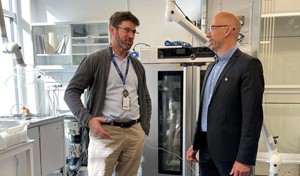News
Corvus Energy leads research project to optimize combined use of H2 fuel cells and batteries in vessel propulsion
Corvus Energy announced that it has been selected to lead an IPN project – a program funded by the Research Council of Norway to promote innovation in the industry. Corvus Energy joins forces with research institute NORCE and other partners for the project, which has been awarded $1.38 MM in funding.
The industrial project, titled “Optimized Hydrogen Powered Maritime Mobility” or OptHyMob for short, will improve operations of H2-driven marine vessels to reduce costs and extend the lifetime of both the H2 fuel cells and the batteries in hybrid configurations. The project builds on the ongoing H2NOR project, funded in part by Innovation Norway, where Corvus Energy and partners will develop, demonstrate and certify the inherently gas-safe modularized maritime PEM-based FC system based on technology from world leader Toyota.
Project outcomes will advance zero-emission shipping
The lifetime of current fuel cell installations and high cost of hydrogen are barriers for upscaling the hydrogen-driven vessel,” said Svenn Kjetil Haveland, Vice President of Development Projects at Corvus Energy. “By solving this we can accelerate decarbonization of shipping.”
“The knowledge gained, as well as the models and systems developed through the OptHyMob project, will enable cost-effective use of hybrid fuel cell-battery systems applied for ship propulsion,” said Haveland. “Through increased efficiency, and extended lifetime of the systems, the total cost of ownership will be reduced. which is essential to the maritime industry’s progress toward zero-emission fuels.”
The project’s aim is cost-effective H2 ship propulsion
The power usage and hence the vessel’s energy consumption will vary a lot for different operational modes, such as acceleration and transit, and depend upon weather conditions and waves etc. In addition, the H2 consumption in a fuel cell system will vary depending on how the system is operated.
“Simply stated, a fuel cell system prefers a stable load, but the power requirement fluctuates rapidly. To increase the effectiveness and lifetime of the fuel cell system you also need batteries, and it is vital to optimize the continuous balance of power from the fuel cell system and power from the batteries,” said Haveland. “The project will develop models and systems for real-time recommendations of optimal load distribution that system integrators may utilize in the power management system.”
Leading edge R&D into fuel cell + battery hybrid operation
This project will perform its research in close collaboration with and in relation to another Research Council funded KSP project, titled “Energy efficient operation of hydrogen-powered vessels” or HyEff for short, led by NORCE and involving the same partners.
“This IPN project performed in tandem with the KSP HyEff project will provide unique knowledge transfer between academia and the industry and establish best practices in batteries and fuel cell hybrid operation into the Norwegian and, ultimately, the global maritime industry in its quest towards zero-emission shipping and maritime transportation,” said Fionn Iversen, Chief Scientist at NORCE.
The projects will combine experimental and full-scale operational data to develop a cost-optimized system that can recommend the optimal load distribution between fuel cells and batteries applied for ship propulsion. Next-minute wave and load predictions will be developed using physics-based and data-driven models, which will be implemented in an industrial clustered edge computing infrastructure.
In addition, research on degradation mechanisms in batteries and FC systems used in maritime applications will be performed to determine how these components affect each other and how they can best be combined to limit system degradation and extend system lifetime.
“Both the OptHyMob project led by Corvus and the HyEff project fit well into the Norwegian Government’s overall commitment to green shipping,” said Haveland. Iversen added, “They correlate well with the ambitions for the Government-funded Norwegian Center for Hydrogen Research – HyValue FME.”


